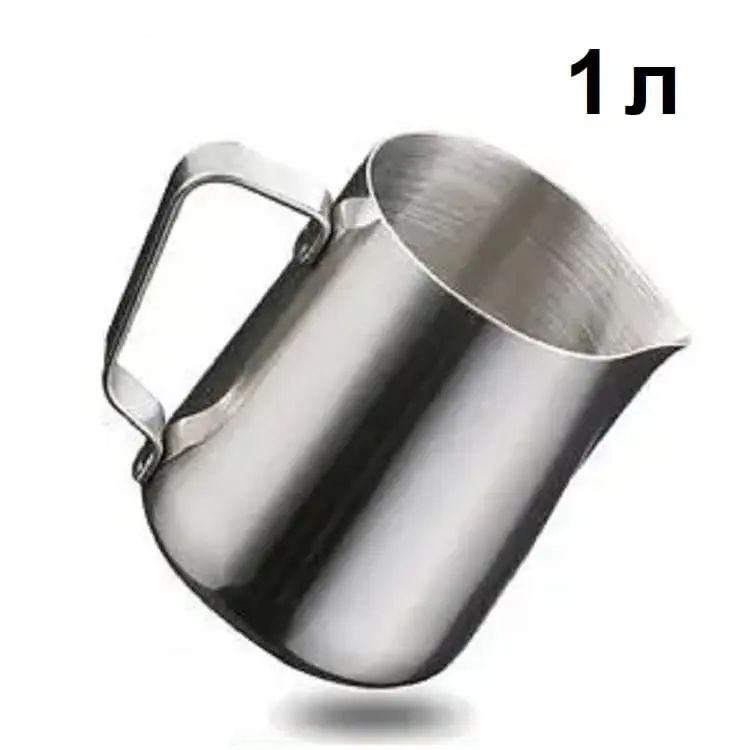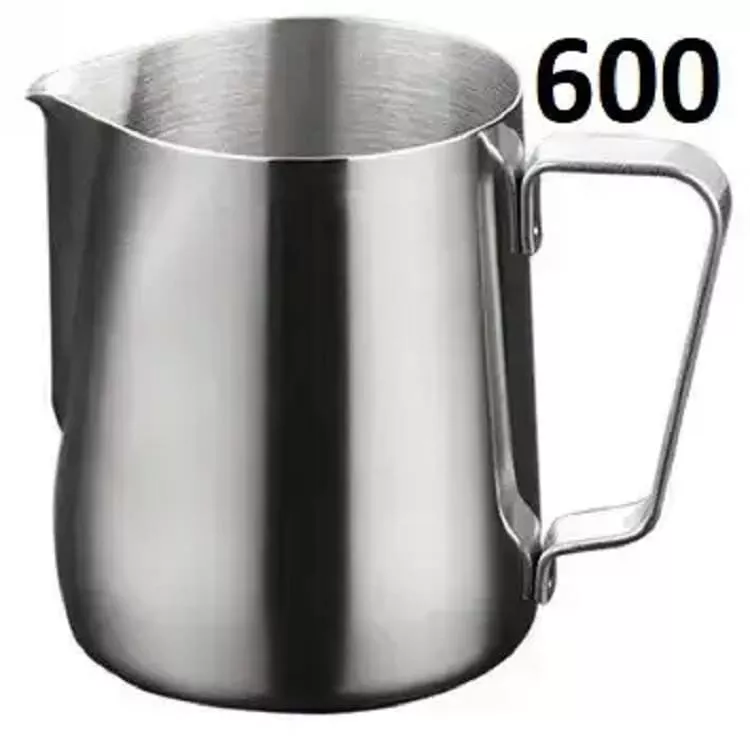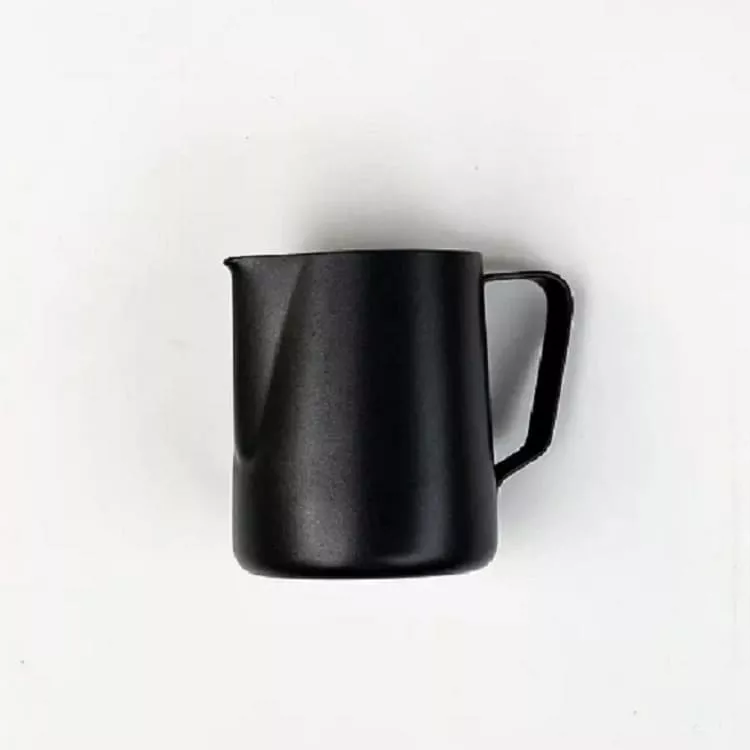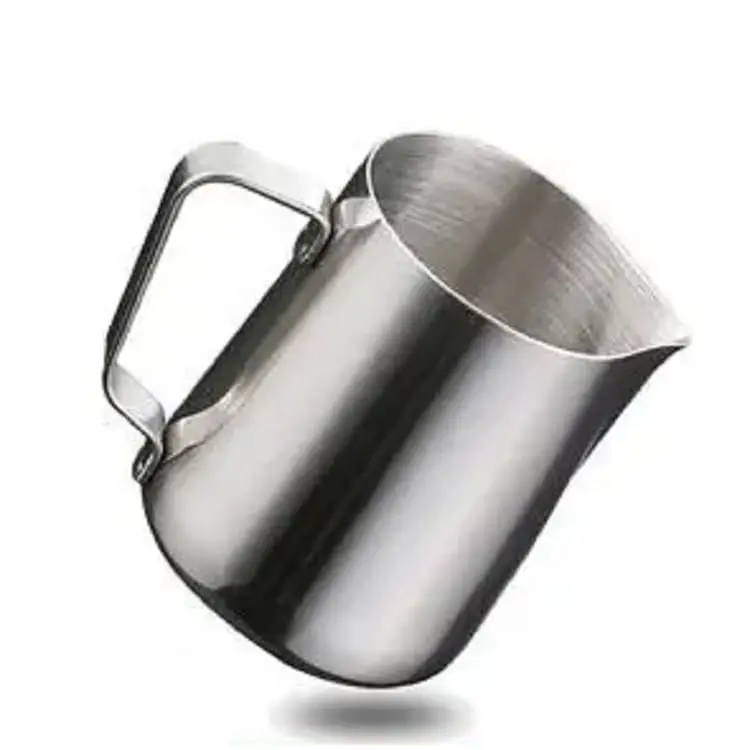Milk pitchers
A pitcher is a special utensil for frothing milk and preparing milk-based coffee drinks such as lattes, cappuccinos or macchiatos.
Its main role is to froth milk to the desired texture. It helps control the evenness of heating, as well as the speed and intensity of stirring, which affect how smooth and creamy the foam will be.
A pitcher for frothing milk is an indispensable tool for latte art. Baristas use it to create a soft and stable milk foam that allows you to draw patterns on the surface of the drink.
Sometimes a pitcher is called a milk jug, but this is not entirely correct, since a milk jug is more of a container for storing and serving milk.
In some English-speaking countries, the term Jug is used.
Jugs can be of different volumes and are used for the same purpose as pitchers, but the term is more often used for larger pitchers not intended for latte art.
Types and materials of pitchers
Pitchers are made of different materials. They affect the ease of use, durability of the container, and quality of the foam.
- Stainless Steel:
The most popular material among baristas, due to its resistance to corrosion, ease of care and heat retention. Stainless steel provides a stable temperature. The milk heats evenly, which is very important for achieving perfect froth.
The only drawback of stainless steel pitchers is their weight, which may make them less convenient for some users, especially beginners.
- Aluminum:
Light and inexpensive material compared to stainless steel, which makes aluminum models more affordable for home use.
With professional use, it can quickly become unusable, since aluminum is not resistant to damage and oxidizes quickly. Over time, these defects can begin to spoil the taste of the milk.
- Copper:
This material conducts heat well, which allows you to precisely control the temperature of the milk. The cost of copper pitchers is higher, despite the fact that this material is prone to corrosion and requires special care.
- Ceramics:
Ceramics retain heat well, can have an aesthetic appearance, but pitchers made of it are quite heavy and inconvenient, and they are also fragile. They are more often used for serving.
- Glass:
Glass is transparent, and this is an undeniable plus. The elegant appearance and the ability to see the level of milk in the container, ease of care are the main features that attract baristas. Glass models are easy to clean, do not absorb odors and the taste of milk. However, they are very fragile, and they must be used carefully, which is not so easy with intensive work.
- Teflon coating:
This high-quality non-stick coating prevents milk from sticking to the walls and makes care much easier. Lightweight, corrosion-resistant, environmentally friendly pitchers with a Teflon coating also maintain temperature perfectly.
They ensure efficiency of use and speed of customer service.
- Plastic:
Light and cheap plastic is used in budget models of pitchers for beginners. The low price is the only plus. There are a number of disadvantages: it does not retain heat, does not guarantee uniform whipping of milk and, as a result, obtaining high-quality foam.
So we conclude that the material has a significant impact on the quality of the drink.
For professional use, we choose stainless steel models or those with a Teflon coating, that is, those that provide thermal insulation and temperature control, and are also chemically neutral. These conditions are critically important for creating a homogeneous, creamy foam.
You can buy both Teflon-coated pitchers and stainless steel models from us.
Selection criteria
When choosing the perfect pitcher for whipping, pay attention to the following criteria:
- Volume
The volume of the pitcher is of great importance, since choosing the right size affects the convenience and efficiency of preparing dairy drinks.
Standard sizes are considered to be containers with a volume of 350 ml, 600 ml and 1 liter. The choice depends on the amount of milk you plan to froth and the number of servings you want to prepare at one time.
For lattes or cappuccinos, pitchers with a volume of 350-600 ml are usually used, which allow you to conveniently froth milk for one or two servings. For large portions or a larger quantity, the 1 liter option is suitable.
Professionals usually prefer the 600 ml volume, as this is the optimal size for most coffee drinks and a convenient option for controlling the frothing process.
Kyiv City Roastery offers models of standard sizes – 350 ml, 600 ml and 1 liter.
- Shape and design
The shape of the pitcher greatly affects the convenience of stirring and creating patterns on the milk foam. For latte art, which requires maximum control over the flow of milk, the shape of the spout should be narrowed to the top or have a special shape. A thin spout helps create complex patterns with small details. It is also important that the jug is comfortable to hold, as the frothing process can be quite long. The handle should be comfortable and not slip in your hands during use. Some models are equipped with rubber or plastic elements on the bottom to prevent slipping.
The classic pitcher has a standard cylindrical shape with a small spout. The conical shape allows for better whipping, as it ensures uniform movement of the milk during frothing, and thanks to the wide base, it is easier to create a dense foam.
- Wall thickness and temperature control
The thickness of the pitcher’s walls is of great importance for uniform heating of the liquid. Thick walls provide better temperature control, preventing overheating or insufficient heating of the milk. This allows you to get the perfect milk foam – smooth, thick and stable. Materials with better thermal insulation properties, such as high-quality stainless steel, help maintain the temperature of the milk during whipping, which is important for achieving the desired texture.
The thin walls, however, can be useful for beginners. When using a jug, a person without experience should simply listen to their own feelings. When it becomes uncomfortable and hot to hold, you need to stop stirring. If the milk is overheated to a temperature above 75℃, the texture of the foam will deteriorate, and an unpleasant taste of boiled milk will appear.
Beginners are advised to use immersion thermometers. This is a special tool for monitoring the temperature of milk. It allows you to monitor the ideal conditions for whipping.
Thermostats can be built into the pitcher. These are used by both beginners and experienced coffee masters. Professionals thus shift the focus of attention from monitoring the temperature to the technique of whipping and latte art.
Professional use
Professional use requires precision and skill.
In order to whip milk qualitatively, first of all, you need to choose it correctly. It must be fresh, cold, and have a high fat content. Skimmed milk will not give enough foam.
To achieve the ideal texture, it is poured into the pitcher taking into account the volume of the drink, after which the container is placed under the cappuccino maker.
The whipping process consists of 2 stages.
1) Foaming, which occurs until the milk warms up to 37℃. In the process, a funnel forms in the liquid, the volume increases, and foam is formed.
2) Steam heating. This is the process of forming the texture of the foam.
The end of the nozzle should be placed near the wall of the pitcher at an angle to the liquid. Often the cappuccinatore is supported on the spout for convenience.
Under the pressure of steam, the milk begins to rotate clockwise. You need to listen to the hissing sound. As the level of foam increases, the pitcher should be gradually immersed deeper. If you do it right, the sound will not change. In fact, the whole process is very fast.
Baristas warn that milk overheated in the first stage produces dry foam.
If you are using a metal pitcher, then focus on the temperature of the bottom. As soon as you feel that it is warm, proceed to the second stage.
The cappuccinatore should be deepened and moved away from the wall. At this stage, there should be no hissing sound. And the funnel turns into a stormy sea with waves. We continue to hold and warm it as long as possible. When the temperature of the walls reaches 65-70 °C, the process is complete.
It is important not to overheat, so as not to get the taste of boiled milk, lack of foam and not lose the natural sweet taste.
There are cappuccinators with three and four holes in the tip.
Then the technique is slightly different. The cappuccinator is not located near the wall, but in the center. In the second stage, it is simply immersed deeper.
To create a pattern on the surface of the coffee, it is important to achieve a uniform, smooth microfoam, without large bubbles. Baristas use a pitcher with a narrow spout for precise work.
As with everything, it takes skill, so professionals usually train their hand movements to pour milk at different speeds to achieve clear patterns.
Beginners often do not control the temperature of the milk. This leads to overheating and loss of foam texture. The second common mistake is insufficient foaming, which occurs due to too deep or shallow immersion of the cappuccinatore.
Care and operation
To ensure long service and maintain the quality of coffee with milk, the pitcher needs to be cared for.
It is important to wash it thoroughly after each use to prevent the accumulation of milk fat and bacteria. To do this, use warm water and mild soap. Particular attention should be paid to cleaning the spout, residues can affect the taste of subsequent servings. Special products for cleaning the milk system of the coffee machine help remove complex contaminants. Regularly cleaning the steam pipes from scale helps maintain the efficiency of the pitcher and coffee machine.
It is best to let it dry naturally or wipe it with a soft towel after cleaning, and then place it in a dry, clean place for storage. It is worth avoiding mechanical damage and preventing corrosion. In order not to damage metal models, you should not use aggressive chemicals.
Tips for choosing and purchasing
Choosing the perfect milk pitcher is a key step on the way to making high-quality coffee.
When choosing, pay attention to the shape, material, size, and suitability for the drink you plan to prepare, as well as the features of caring for the jug to ensure not only ease of use but also durability.
Classic stainless steel options with a volume of 350-600 ml or 1 liter for several servings are optimal.
The shape of the spout and the convenience of the handle are also important, especially if you plan to do latte art.
In our store you can buy the best models, time-tested and recommended by professionals, at very reasonable prices, from 220 UAH to 610 UAH depending on the material, manufacturer, and size.
If you are looking to improve your professional latte art skills or simply prepare and enjoy delicious coffee at home, it is important to take the time to choose and buy a milk pitcher that will allow you to reveal your barista talent. And to ensure that your choice is optimal, our managers will always be happy to advise you.






